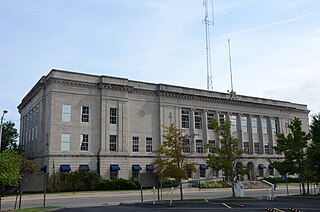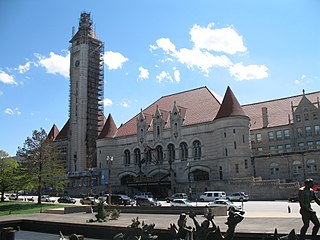Related Research Articles

Muskogee County is a county located in the U.S. state of Oklahoma. As of the 2010 census, the population was 70,990. The county seat is Muskogee. The county and city were named for the Muscogee (Creek) Nation. The official spelling of the name was changed to Muskogee by the post office in 1900.
Haskell is a town in Muskogee County, Oklahoma, United States. The population was 2,007 at the 2010 census, a gain of 13.7 percent over the figure of 1,765 recorded in 2000. Haskell was established in 1904 on the Midland Valley Railroad. It was named for town site developer Charles N. Haskell, who would become the first governor of the State of Oklahoma in 1907.

Muskogee is the eleventh-largest city in Oklahoma and the county seat of Muskogee County. Home to Bacone College, it lies approximately 48 miles (77 km) southeast of Tulsa. The population of the city was 36,878 as of the 2020 census, a 6.0 percent decrease from 39,223 in 2010.
Warner is a town in Muskogee County, Oklahoma, United States. The population was 1,641 at the 2010 census, an increase of 14.8 percent over the figure of 1,430 recorded in 2000. The town is home to one of the two Connors State College campuses.
The Midland Valley Railroad (MV) was a railroad company incorporated on June 4, 1903 for the purpose of building a line from Hope, Arkansas, through Muskogee and Tulsa, Oklahoma to Wichita, Kansas. It was backed by C. Jared Ingersoll, a Philadelphia industrialist who owned coal mining properties in Indian Territory. The railroad took its name from Midland, Arkansas, a coal mining town in western Arkansas, which was served by the railroad. The Midland Valley gained access to Fort Smith, Arkansas via trackage rights over the Frisco from Rock Island, Oklahoma.

The Northwestern Pacific Railroad is a railroad covering the 62 mi (100 km) stretch between Schellville and Windsor with freight and Sonoma–Marin Area Rail Transit (SMART) commuter trains. Formerly, it was a regional railroad primarily used for logging that served the entire North Coast of California, with a main line running 271 miles (436 km) from Schellville to Eureka, along with an additional portion of the line running from the Ignacio Wye to the edge of San Rafael. The portion of the NWP main line between the Larkspur Station in Marin County and the depot in Healdsburg is currently owned by SMART. The Schellville–Ignacio and Healdsburg–Eureka portions are owned by the North Coast Railroad Authority (NCRA). Private contractor NWPco operates freight service under NCRA lease. California's 2018 Great Redwood Trail Act repurposes the abandoned railroad right-of-way from Eureka to the San Francisco Bay in Marin County for future use as the Great Redwood Trail.
The Oklahoma City – Ada – Atoka Railway (OCAA) was formed from trackage from Oklahoma City to Atoka via Shawnee, Ada, and Coalgate, Oklahoma. Atoka to Coalgate had been built between 1882 and 1886 as feeder to the old Missouri–Kansas–Texas Railroad (Katy) main line, and Coalgate-Shawnee-Oklahoma City had been constructed by Katy affiliates, and specifically the first 40 miles northwest out of Coalgate having been built by the Texas and Oklahoma Railroad in 1902, and the remaining 78 miles into Oklahoma City having been built in the 1903-1904 timeframe by that line’s successor, the Missouri, Kansas and Oklahoma Railroad Company. However, these properties were not included in the 1923 reorganization of the Katy, and were put in the OCAA instead. The OCAA ended up being sold to the Muskogee Company in 1929, becoming one of the Muskogee Roads.

The Arkansas–Oklahoma Railroad is a Class III carrier headquartered in Wilburton, OK that operates two segments of the former Chicago, Rock Island and Pacific Railroad (CRIP) Choctaw Route that originally ran between Memphis Tennessee and Tucumcari, New Mexico. AOK started operations on March 3, 1996 on 73 miles of track then owned by the U.S. state of Oklahoma between Howe and McAlester by assuming the existing lease of the Missouri Pacific, then wholly owned by the Union Pacific Railroad (UP). This lease included a purchase option which was exercised by AOK in April 2016. The line interchanges with the Kansas City Southern Railway at Howe, and with the UP at McAlester.

The Terminal Railroad Association of St. Louis is a switching and terminal railroad that handles traffic in the St. Louis, Missouri, metropolitan area. It is co-owned by several Class I railroads that reach the city.
The Muskogee Company, although a Philadelphia company, was founded in Delaware on February 27, 1923. The company officers were brothers C. Jared Ingersoll, industrialist, as president, and John H. W. Ingersoll, attorney and industrialist, as vice president and treasurer. The Muskogee Company owned large interests in several railroads in and about northeastern Oklahoma.
The Muskogee Roads was the colloquial name for a system of railroads under common management operationally headquartered in Muskogee, Oklahoma and controlled by the Muskogee Company of Philadelphia. The Muskogee Roads were the only Class I railroads to be headquartered in Oklahoma and had a major impact on the development and livelihood of the region.
The Osage Railway was incorporated in 1921 to accommodate traffic from the oil fields located in the Osage Nation. The first part of its mainline was constructed in 1922 from a connection with the Midland Valley Railroad at Foraker, Oklahoma, to the town of Shidler, Oklahoma, about 10 miles southwest. The line was independently owned from the Midland Valley, but was jointly operated with the Midland Valley and two other lines as part of the Muskogee Roads. Beginning July 2, 1923 and completing in early 1924, the Osage Railway's trackage was extended northwesterly from Shidler through Webb City to Lyman, Oklahoma, about another 6 miles.
The Wichita Falls and Oklahoma Railway, together with its affiliate the Wichita Falls and Oklahoma Railroad of Oklahoma, built a line from Wichita Falls, Texas to Waurika, Oklahoma in two stages, starting in 1903 and completing in 1923. Results were disappointing, and the line was abandoned in late 1942.
The Texas and Oklahoma Railroad (T&O) existed briefly from its incorporation in mid-1902 to its consolidation with another line at the end of 1903. Its main accomplishment was to construct 40 miles of track northwest out of Coalgate, Oklahoma.
The Texas and Oklahoma Railroad (TXOR), created in 1991, ran between Oklahoma and Texas on rail purchased from the Atchison, Topeka and Santa Fe Railway (AT&SF). Much of the trackage has since been sold or abandoned; however, the railway continues to exist as a shortline carrier operating between Sweetwater, Texas and Maryneal, Texas.
The Eastern Oklahoma Railway was incorporated under the laws of Oklahoma Territory on July 24, 1899. The railroad constructed much of its own track. This included Guthrie junction to Cushing junction, 47.9 miles, in the 1900-1902 timeframe; Ripley to Esau Junction, 40.4 miles, also in the 1900-1902 timeframe; Newkirk to Pauls Valley, 182.5 miles, in the 1900-1904 timeframe; and, Davis to Sulphur, 9.3 miles, in 1906.
The Kiowa, Chickasha and Fort Smith Railway (KC&FS) came about when the Atchison, Topeka and Santa Fe Railway (AT&SF) and the Chicago, Rock Island and Pacific Railroad decided to build an interchange linking their systems at a point halfway between the towns of Chickasha and Pauls Valley in what is now the State of Oklahoma. Toward that goal, the AT&SF incorporated The Kiowa, Chickasha and Fort Smith Railway Company in Kansas on July 13, 1899, which then built a line from Pauls Valley to what became the town of Lindsay, a distance of 24.2 miles, in the 1901-1903 timeframe. The line’s first operation was in December of 1903.
The Ozark and Cherokee Central Railway (O&CC) was formed under the name of the North Arkansas & Western Railway in 1899. At its maximum, it owned a standard gauge, single track line running between Fayetteville, Arkansas and Okmulgee, Oklahoma. Its assets were merged into the St. Louis and San Francisco Railway (Frisco) in 1907.
The Muskogee Electric Traction Company (“Traction”) was an electrified streetcar line operating in and around Muskogee, Oklahoma from 1904 to 1941, with bus passenger service continuing under that name to 1958.
The Webbers Falls Railroad (W.F.R.R.) was a shortline railway operating between the towns of Webbers Falls and Warner in the State of Oklahoma. Its predecessor began operations in 1911, and its line was dismantled by 1918.
References
- ↑ "Three Forks History: Muskogee once served by five railroads". Jonita Mullins, Muskogee Phoenix, November 28, 2015. Archived from the original on November 3, 2021. Retrieved September 26, 2022.
- 1 2 3 4 "Muskogee Depot and Freight District, National Register of Historic Places Registration Form". National Park Service. Archived from the original on September 28, 2022. Retrieved September 28, 2022.
- ↑ "Muskogee Oklahoma to Warner Oklahoma, et al". Google Maps. Retrieved September 27, 2022.
- 1 2 "Midland Valley Railroad Company". Railroads of Oklahoma, p.50. Archived from the original on May 18, 2021. Retrieved September 28, 2022.
- ↑ "Oklahoma 2018-2020 State Railroad Map" (PDF). Oklahoma Department of Transportation. Archived (PDF) from the original on September 21, 2021. Retrieved September 28, 2022.